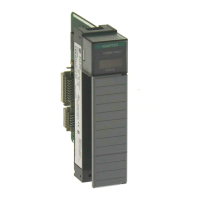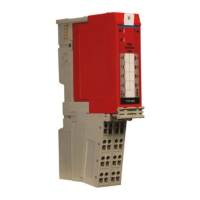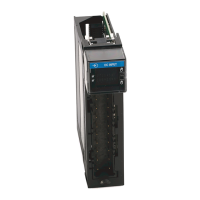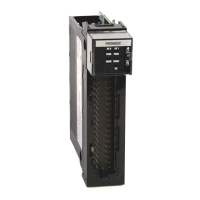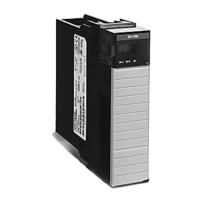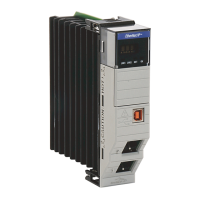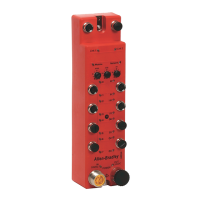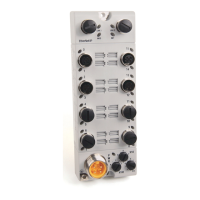Rockwell Automation Publication 1734-UM020B-EN-E - August 2019 39
Configure the POINT I/O 4 Channel IO-Link Master as IO-Link Master Using the Studio 5000 Add-on Profile Chapter 4
Status
(continued)
6. Device on IO-Link Master. IODD file in Device only.
There is a device connected to the master but no device configured for the channel in the project. The device has an IODD file
that is not registered in the device catalog on the workstation. You can choose to “use” this channel configuration. Doing so
retrieves the IODD file from the device and registers it on the workstation. This action also configures the channel with the
device that was discovered.
7. Device on IO-Link Master and in Project are the same. The IODD file in the Device is older.
There is a device connected to the master that matches the device configured for the channel in the project. The device has an
IODD file that is older than the file registered in the device catalog on the workstation. You do not have to take any action. You
can choose to register the IODD file but only the latest IODD file in the device catalog is used.
8. Device on IO-Link Master and in Project differ. The IODD file in the Device is older.
There is a device connected to the master but it does not match the device configured for the channel in the project. The device
has an IODD file that is older than the file registered in the device catalog on the workstation. You can choose to “use” this
channel configuration. Doing so replaces the device configured for the channel with the device that was discovered. You can also
choose to register the IODD file, but only the latest IODD file in the device catalog is used.
9. Device on IO-Link Master. The IODD file in the Device is older.
There is a device connected to the master but no device configured for the channel in the project. The device has an IODD file
that is older than the file registered in the device catalog on the workstation. You can choose to “use” this channel configuration.
Doing so configures the channel with the device that was discovered.
10.Device on IO-Link Master and in the Project are the same. The IODD file in the Device is newer.
There is a device connected to the master that matches the device configured for the channel in the project. The device has an
IODD file that is newer than the file registered in the device catalog on the workstation. You can choose to “use” this channel
configuration. Doing so retrieves the IODD file from the device and registers it on the workstation.
11.Device on IO-Link Master and in the Project differ. The IODD file in the Device is newer.
There is a device connected to the master but it does not match the device configured for the channel in the project. The device
has an IODD file that is newer than the file registered in the device catalog on the workstation. You can choose to “use” this
channel configuration. Doing so replaces the device configured for the channel with the device that was discovered. You can also
choose to register the IODD file. Doing so retrieves the IODD file from the device and registers it on the workstation.
12.Device on IO-Link Master. The IODD file in the Device is newer.
There is a device connected to the master but no device configured for the channel in the project. The device has an IODD file
that is newer than the file registered in the device catalog on the workstation. You can choose to “use” this channel
configuration. Doing so configures the channel with the device that was discovered. You can also choose to register the IODD
file. Doing so retrieves the IODD file from the device and registers it on the workstation.
13.Device on IO-Link Master and in the Project differ. IODD file in Catalog only.
There is a device connected to the master but it does not match the device configured for the channel in the project. The device
has no IODD file but there is a file for the device registered in the device catalog on the workstation. You can choose to “use”
this channel configuration. Doing so replaces the device configured for the channel with the device that was discovered.
14.Device on IO-Link Master. IODD file in Catalog only.
There is a device connected to the master but no device configured for the channel in the project. The device has no IODD file but
there is a file for the device registered in the device catalog on the workstation. You can choose to “use” this channel
configuration. Doing so configures the channel with the device that was discovered.
15.Device on IO-Link Master and in the Project differ. No IODD file available. Create Generic Device.
There is a device connected to the master but it does not match the device configured for the channel in the project. The device
has no IODD file and there is no file for the device registered in the device catalog on the workstation. You can choose to “use”
this channel configuration. Doing so replaces the device configured for the channel with a generic device profile.
16.Device on IO-Link Master. There is no IODD file available. Create Generic Device.
There is a device connected to the master but no device configured for the channel in the project. The device has no IODD file
and there is no file for the device registered in the device catalog on the workstation. You can choose to “use” this channel
configuration. Doing so replaces the device configured for the channel with a generic device profile.
17.Device on IO-Link Master and in the Project are the same. The IODD file is already registered.
There is a device connected to the master that matches the device configured for the channel in the project. The device has an
IODD file that matches the file for the device registered in the device catalog on the workstation. You can choose to register the
IODD file.
18.Device on IO-Link Master and in Project are the same. IODD File in Catalog only.
There is a device connected to the master that matches the device configured for the channel in the project. The device has no
IODD file but there is a file for the device registered in the device catalog on the workstation.
Device Discovery Dialog
Parameter Description
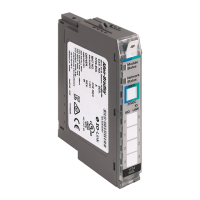
